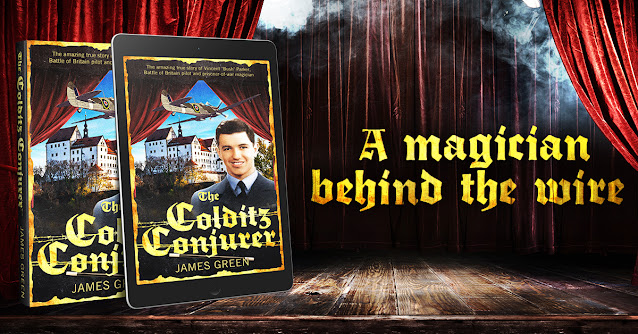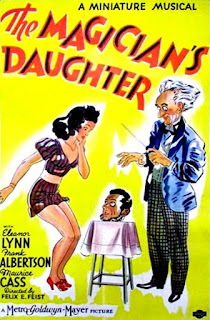Wilfred Ponsonby: a conjuror in captivity (Part 1)
In this three-part blog, we tell the story of Wilfred ('Wilf') Ponsonby, a British army officer and amateur magician captured by the Germans in the Battle of France in 1940. In a remarkable set of events, Ponsonby ends up heading an escape committee, writing coded letters to British military intelligence, and supervising the use of secret escape devices. At the same time, he boosts the morale of his fellow POWs as the camp's resident magician. Ponsonby takes part in several escapes and makes it back to England before the war is over...
An early escape, discovering magic and joining the army
Wilfred Ponsonby kept up magic through school, and after he joined the army. He gave his first public performance in 1926, as an army officer. While based in Woolwich, he often frequented Will Goldston’s magic shop (near Trafalgar Square), joined Goldston’s Magicians’ Club of London, and subscribed to The Sphinx magic magazine.
Ponsonby used animals in his early shows; two rats, four pigeons and a duck. Wherever he travelled with the army, he would take his props (and animals) with him, often performing at military dinner nights and other formal events.
Early military life
One of Ponsonby’s first assignments was as a military horse-riding instructor. This cemented his lifelong interest in horses and horse racing. An accomplished rider, he made several appearances in horse displays at the annual Royal Tournament. Alongside his horse-riding duties, Ponsonby became an expert in military communications and promoted to captain rank.
He married in 1935, and over the next two decades, had six children.
Captain Ponsonby was posted in India in 1938 and put in charge of a Cavalry Brigade Signal Troop. When war was declared, he returned to England, was promoted to major, and posted to a signals’ unit in 1st Armoured Division.
For the Allies, the first eight months of the war following Nazi Germany’s invasion of Poland were known as the ‘Phoney War,’ with little actual warfare. Then, as winter turned to spring, Hitler’s forces invaded Denmark (April 1940), Norway (April 1940), followed by Belgium, the Netherlands, Luxembourg and France (May 1940). To help protect their Allies, Britain deployed the British Expeditionary Force (B.E.F.) to France, in September 1939. Most of its time was spent digging field defences on France’s northern borders.
As Nazi Germany started its Blitzkrieg (German: lightning war) invasion of Western Europe, the B.E.F. was rapidly reinforced. The Battle of France started on 10 May 1940 and a week later, on 16 May, Ponsonby’s unit moved out to France as part of the 51st (Highland) Infantry Division.
Before they left for mainland Europe, H.M. King George VI. inspected Ponsonby’s unit. Ponsonby met the King again, four years later, with quite a story to tell.
The Battle for France… capture, escape, and recapture
At 9 p.m. on 9 May 1940, the code word ‘Danzig’ was relayed to all German army divisions, beginning their invasion. The B.E.F. advanced to meet the German forces. A month earlier, the 51st Division was detached from the rest of the B.E.F. and put under command of the French. It wasn’t part of the advance into Belgium. Instead, the 51st Division pulled back to hold a defensive line along the River Somme. The overwhelming German attack forced the B.E.F. back to the sea, leading it to evacuate from Dunkirk from 26 May to 4 June.
Further south, a heavy German attack got in between the British and French armies, cutting off the 51st Division from the rest of the British forces. The 51st Division withdrew to the coast, headed for St. Valery-en-Caux, a coastal town south of Dieppe. The Royal Navy was alerted on 10 June to evacuate the British force, but the small port was far from ideal for such an operation.
With the Germans surrounding and attacking the British troops defending the town, the 51st Division’s situation was becoming untenable. When the French capitulated on 12 June, and it was confirmed that the Royal Navy couldn’t mount a suitable evacuation, the division was left with little option but to surrender.
Captain Ponsonby and his signals squadron were among 10,000 other exhausted and demoralised British troops. With the town surrounded, there was little chance of evading capture. Over the next few days, the Germans rounded them up, formed them into columns, and started marching them east to Germany.
In the early morning on the third day of the march, Ponsonby slipped out of the column undetected by the German guards. Together with a colleague, he persuaded some locals to give them civilian clothes and passed themselves off as Frenchmen. The evaders headed north towards the Dunkirk area, hoping to find a boat to cross the English Channel. Food was not a problem, as Ponsonby and his friend had money with them. And the local French community did what they could to help.
After several days, the pair made it to Dunkirk. But the Germans were closely monitoring French boats going out of local harbours, looking for British stragglers. Changing their plan, the pair of British soldiers headed to Boulogne-sur-Mer, a coastal city 50 miles southeast of Dunkirk.
Secret codes and gadgets
Schloss Spangenberg is a thirteenth-century castle perched on an escarpment overlooking the town which bears its name. Early in World War Two, it became a prisoner-of-war camp. Surrounded by a moat, the castle was ideal as a POW camp (playing that role in previous wars). It was designated as Oflag IX A/H, with the castle known as the upper camp and a converted farmhouse down the hill in the village of Elbersdorf known as the lower camp, or Haina Kloster.
Ponsonby arrived at Spangenberg in early August 1940. There were very few prisoners there, but it quickly filled up.
After a time, the guards separated the navy, army and air force POWs. The navy and air force stayed in Spangenberg, while the army moved down to the lower camp.
Ponsonby was appointed as the camp adjutant, the Senior British Officer’s (S.B.O.) right-hand man. He held the position for over a year.
He also held a more secretive responsibility, as head of Elbersdorf’s escape committee.
All proposed escapes had to go through the escape committee so they could be coordinated and supported. But running an escape committee was no simple task, especially in Elbersdorf:
"Two hundred officers were confined in a space only seventy-five yards square, surrounded by a barbed wire fence nine feet high and nine feet thick, overlooked by armed sentries equipped with machine guns and floodlights. So, they had no privacy from each other or from their captors, and this could not get none of the preliminary tailoring, pass-forging, map-studying done, without which an escape stood no chance of success." Plus, one side of the camp bordered a river, which ruled out tunnelling from that side.
Ponsonby’s first challenge was providing escape materials for would-be escapers.
“I was faced with running the escape club, and of course we needed money, compasses, maps and so on, but how do you get them? That was the problem.”
Potential help came in the form of an organisation known as M.I.9 (Directorate of Military Intelligence Section 9). Set-up in 1939 to help British POWs escape and evade capture, it started manufacturing escape aids, such as silk maps and button compasses. The organisation hid these in games and recreation equipment, which were sent out to POW camps in welfare packages. The man behind M.I.9's escape devices was Christopher Clayton Hutton; someone with a devious magical mind (and who'd challenged Harry Houdini to an escape in his youth).
In mid-1940, though, M.I.9 was still developing its modus operandi and wasn’t yet in a position to help the Elbersdorf POWs. Later in the war, escape materials became readily available in many P.O.W. camps, provided by M.I.9 and M.I.S.-X, its American equivalent.
Even if Ponsonby wasn’t aware of M.I.9 at this stage of the war, he knew that if he could contact the British authorities, someone could send through items to help the POWs escape. The German authorities read and censored letters from POWs, so this call for help needed to be done secretly.
Over time, M.I.9 introduced codes and briefed these to carefully picked individuals, such as pilots and intelligence officers. As these servicemen got captured, they would begin writing to M.I.9 and spread knowledge of the codes to other trusted POWs.
But, before these codes became widespread, individual prisoners used personal, unofficial codes. These were set up with their family and friends before leaving Britain. Ponsonby used one of these to communicate with his brother-in-law, who worked for M.I.6. He hoped that his brother-in-law would realise the letter contained a code and pass it to his colleagues to be deciphered and acted on.
Ponsonby sent his first coded letter in October 1940. Five months later, he received a reply using the same code. With contact established, he kept in touch with military intelligence for the rest of his time as a POW.
Soon after he heard from his brother-in-law, Ponsonby received regular parcels containing hidden materials. These included skittles and hardcover books with money in them, or compasses, maps and hacksaws in games or food items. When the escape committee approved an escape, they would give out these escape supplies as they were needed.
“One of my first escape client who said he was interested in escaping was Airey Neave, who was, in fact, one of the first escapers from Colditz.”
Neave didn’t escape from Oflag IX-A/H. But, after a failed escape at another POW camp, he ended up in Oflag IV-C (Colditz Castle). Airey Neave was famously the first British officer to escape from Colditz. He made it back to England and M.I.9 recruited him to advise on escape matters.
As a communications specialist, Ponsonby also oversaw the operation of a secret radio. It had been smuggled into the camp by a Royal Army Medical Corps officer, who'd hidden the suitcase containing the radio behind a radiator in the corridor leading up to the room where the POWs were searched on arrival in the camp, then he picked it up again on his way out! This was invaluable for giving the POWs access to news from home, and was a tremendous boost to their morale.
The primary source for this article was ‘Quicksilver: The Reminiscences of an Early Recruit of the Royal Signals’, by Wilfred Ponsonby (1995) (edited by Kim Pollit). Other sources include the London Gazette and War Office records held at The National Archives (U.K.). Also, 'M.I.9 - Escape and Evasion 1939-1945' by M.R.D. Foot & J.M. Langley.
Related article: 'The Magician of Stalag Luft III' (Parts 1-3) tells the story of Lieutenant Commander John Casson naval aviator, magician, prisoner-of-war in Stalag Luft III. Blog link
Related article: Verdini: Czech magician escapes Nazi blitzkrieg three times, fights in the Battle of Britain...and joins E.N.S.A., a blog about an Eastern European magician who fought in the Battle of France, evacuated from Dunkirk and then fought in the Battle of Britain, before entertaining Allied troops. Blog link
Related article: 'Hitler's V-Weapons: Magicians and the battle against the V-1 and V-2' gives an account of the impact of Hitler's V-1 and V-2 rockets on magicians, and how some were involved in defeating them. Blog link.
















Comments
Post a Comment